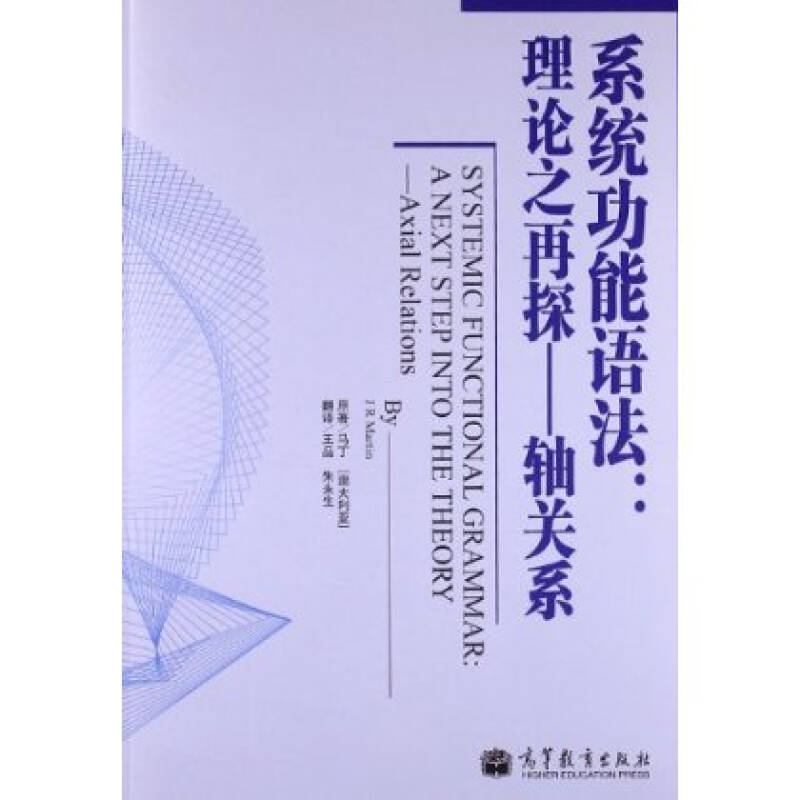《系統功能語法:理論之再探:軸關係(英、漢)》旨在教會學生如何親自動手繪製系統網路。在悉尼,這門討論課每周一次,一學期總計十三周。在其他地方(聖地亞哥、貝洛奧里藏特、聖保羅、弗洛里亞諾波利斯、南昌、南京、北京、歐登塞、里斯本)開設的是為期一周的強化課程。《系統功能語法:理論之再探:軸關係(英、漢)》以不斷解決問題的形式進行組織。在課堂上,學生要分析一系列語料,語料的複雜性不斷增加,每個步驟都會提出網路繪畫方面的新挑戰。
基本介紹
- 外文名:Systemic Functional Grammar: the next step into the theory
- 書名:系統功能語法:理論之再探
- 作者:馬丁 (Martin J.R.)
- 類型:人文社科
- 出版日期:2013年7月1日
- 語種:簡體中文, 英語
- ISBN:7040375184
- 譯者:王品
- 出版社:高等教育出版社
- 頁數:238頁
- 開本:16
- 品牌:高等教育出版社
基本介紹,內容簡介,作者簡介,圖書目錄,
基本介紹
內容簡介
《系統功能語法:理論之再探:軸關係(英、漢)》的目的是為了幫助學者們從系統功能語言學理論和描述的消費者轉變為理論和描述的生產者。
作者簡介
作者:(澳大利亞)馬丁(Martin J.R.) 譯者:王品 朱永生
圖書目錄
ⅠSYSTEMIC FUNCTIONAL GRAMMAR: A NEXT STEP INTO THE THEORY AXIAL RELATIONS
1 Axis
1.1 Overview
1.2 Theoretical foundations
1.3 Outline of this book
1.4 Using this book
1.5 Notational conventions
2 Basic systems (for words)
2.1 Overview
2.2 System network notation
2.3 Pronoun systems-based on English
2.4 Pronoun systems-based on Tagalog
2.5 Typology and topology
2.6 Summary
3 More systems (for structures)
3.1 Overview
3.2 Parsing
3.3 Class and syntagm; function and structure
3.4 Halliday's basic English mood structures
3.5 MOOD systems (based on English)
3.6 MOOD systems (based on Tagalog)
3.7 Summary
4 System networks: metafunction and rank
4.1 Overview
4.2 MOOD, MODALITY, POLARITY and TAGGING
4.3 Metafunction
4.4 Rank
4.5 Structural dependencies
4.6 Recursive systems
4.7 Summary
5 System networks: stratification
5.1 Overview
5.2 MOOD and TAGGING revisited
5.3 Stratification and grammatical metaphor (MOOD)
5.4 Stratification and grammatical metaphor (MODALITY)
5.5 Summary
6 Beyond grammar: axial perspectives
6.1 Overview
6.2 Lexis
6.3 TONE
6.4 Exchange structure
6.5 Context
6.6 Summary
6.7 Envoi
Appendix 1: Glossary
Appendix 2: Systemic conventions
References
Ⅱ 系統功能語法:理論之再探——軸關係
1軸
1.1概述
1.2理論基礎
1.3本書綱要
1.4本書的使用
1.5體例
2基本系統(詞)
2.1概述
2.2系統網路畫法
2.3人稱代詞系統——以英語為例
2.4人稱代詞系統——以漢語為例
2.5類型學與拓撲學
2.6小結
3更多系統(結構)
3.1概述
3.2句法解析
3.3類別與橫組合體;功能與結構
3.4 Halliday提出的英語語氣基本結構
3.5語氣系統——以英語為例
3.6語氣系統——以漢語為例
3.7小結
4系統網路:純理功能與級階
4.1概述
4.2語氣、情態、歸一性及附加疑問套語
4.3純理功能
4.4級階
4.5結構依賴性
4.6遞歸系統
4.7小結
5系統網路:層次化
5.1概述
5.2對語氣和附加疑問套語的重新思考
5.3層次化與語法隱喻(語氣)
5.4層次化與語法隱喻(情態)
5.5小結
6語法之外:軸的視角
6.1概述
6.2辭彙
6.3聲調
6.4交換結構
6.5語境
6.6小結
6.7後記
附錄1:專業術語彙總表
附錄2:系統常規描寫方式
譯者的話
1 Axis
1.1 Overview
1.2 Theoretical foundations
1.3 Outline of this book
1.4 Using this book
1.5 Notational conventions
2 Basic systems (for words)
2.1 Overview
2.2 System network notation
2.3 Pronoun systems-based on English
2.4 Pronoun systems-based on Tagalog
2.5 Typology and topology
2.6 Summary
3 More systems (for structures)
3.1 Overview
3.2 Parsing
3.3 Class and syntagm; function and structure
3.4 Halliday's basic English mood structures
3.5 MOOD systems (based on English)
3.6 MOOD systems (based on Tagalog)
3.7 Summary
4 System networks: metafunction and rank
4.1 Overview
4.2 MOOD, MODALITY, POLARITY and TAGGING
4.3 Metafunction
4.4 Rank
4.5 Structural dependencies
4.6 Recursive systems
4.7 Summary
5 System networks: stratification
5.1 Overview
5.2 MOOD and TAGGING revisited
5.3 Stratification and grammatical metaphor (MOOD)
5.4 Stratification and grammatical metaphor (MODALITY)
5.5 Summary
6 Beyond grammar: axial perspectives
6.1 Overview
6.2 Lexis
6.3 TONE
6.4 Exchange structure
6.5 Context
6.6 Summary
6.7 Envoi
Appendix 1: Glossary
Appendix 2: Systemic conventions
References
Ⅱ 系統功能語法:理論之再探——軸關係
1軸
1.1概述
1.2理論基礎
1.3本書綱要
1.4本書的使用
1.5體例
2基本系統(詞)
2.1概述
2.2系統網路畫法
2.3人稱代詞系統——以英語為例
2.4人稱代詞系統——以漢語為例
2.5類型學與拓撲學
2.6小結
3更多系統(結構)
3.1概述
3.2句法解析
3.3類別與橫組合體;功能與結構
3.4 Halliday提出的英語語氣基本結構
3.5語氣系統——以英語為例
3.6語氣系統——以漢語為例
3.7小結
4系統網路:純理功能與級階
4.1概述
4.2語氣、情態、歸一性及附加疑問套語
4.3純理功能
4.4級階
4.5結構依賴性
4.6遞歸系統
4.7小結
5系統網路:層次化
5.1概述
5.2對語氣和附加疑問套語的重新思考
5.3層次化與語法隱喻(語氣)
5.4層次化與語法隱喻(情態)
5.5小結
6語法之外:軸的視角
6.1概述
6.2辭彙
6.3聲調
6.4交換結構
6.5語境
6.6小結
6.7後記
附錄1:專業術語彙總表
附錄2:系統常規描寫方式
譯者的話

